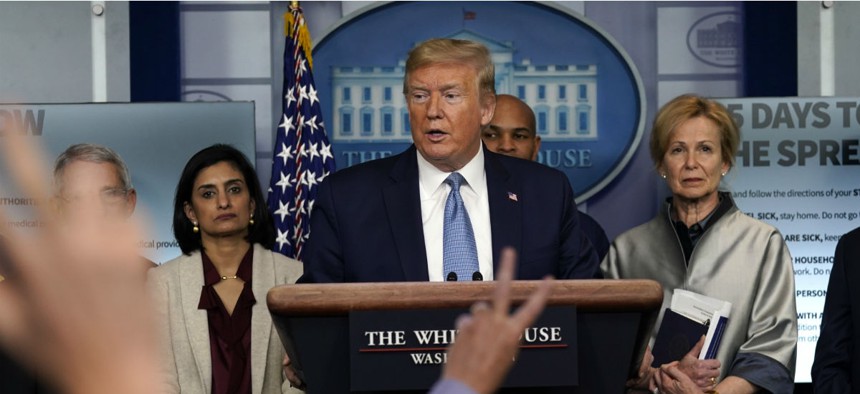
President Trump speaks during a press briefing with the coronavirus task force. Evan Vucci/AP
A Leadership Reality Check
It doesn’t matter how good the plan is to combat the COVID-19 outbreak if leaders don’t lead.
In our all-coronavirus/all-the-time world, there’s an enormous premium on leadership. What can we do to slow the virus down so we can eventually wrestle it to the ground? There’s a paradox here: the plan of action matters much less than we think.
As Robert C. Tucker pointed out in 1981 in his short and lively book, The Politics of Leadership, an answer is worthless unless a leader can rally everyone around a shared understanding of the problem. Consider Franklin D. Roosevelt’s stirring words during his first inaugural, “the only thing we have to fear is fear itself—nameless, unreasoning, unjustified terror which paralyzes needed efforts to convert retreat into advance.”
It was a remarkable opening of the very first speech he gave as president. He didn’t define the problem in the technical terms of an economic collapse. He didn’t lead with a laundry list of stimulus ideas. He defined it as fear, and he told the nation he would transform that fear into victory. That was a gutsy call at a very difficult time. And it worked.
Then there was Roosevelt’s speech the day after the attack on Pearl Harbor. He began the speech by calling December 7 “a date which will live in infamy,” and he used that sense of righteous anger to stir the nation to action.
These were not just great speeches. They were cornerstones of his leadership because he so crisply and inspirationally and inescapably defined the problem in sharp, forceful language. The plans for action flowed directly from his definition of the problem; without that powerful definition, the plans would have hung limp.
And what makes a plan fly fearlessly from the flagpole? The keystone is to convince everyone, from government employees to citizens, to believe that the plan will work.
In part, that’s a matter of competence. Big problems are complex and complex problems need sophisticated answers. Government leaders need to know what they’re doing, and they need to persuade those around them that they have their individual and collective act together.
But none of this matters unless citizens trust that leaders in fact do know what they’re doing—that they’re solving the problem, and that they’re solving the right problem.
That kind of trust is in painfully short supply. A few years ago, the Washington Post conducted a survey of trust in government’s institutions and discovered that Congress was less popular than lice, colonoscopies, and (with apologies to their fans), Nickelback. There’s no sign that wholesale trust in government’s basic institutions is going to improve any time soon. In fact, there’s disturbing evidence that public opinion on the government’s response to the COVID-19 pandemic is breaking down, like so many other issues, on partisan lines.
But in times like these, it’s trust on the retail level that matters: Government can earn our trust if it delivers results on the things we care about. People might hold used car salesmen or root canals in higher esteem than Congress (they do). What earns the public’s trust is whether government’s institutions solve the problems in their neighborhoods and in their towns.
And that, it turns out depends much less on the plan of action than on what Tucker calls the diagnostic power of the leader: seizing a situation and defining it, carefully and authoritatively and decisively, for everyone. It’s the diagnosis that drives action, and that action is what builds the foundation for trust.
In this exceptionally difficult time, that’s the critical but paradoxical message. Everyone is scrambling to write the best plan. But that’s much less important unless leaders lead—and in tough situations, they lead best by building trust that they’re solving the right problem.
In fact, there are two wide roads to deep failure: creating a good plan that no one pays any attention to; and writing a plan that solves the wrong problem. As Roosevelt demonstrated, it’s the ability to build a bridge between diagnosing the situation and implementing the solution that is the hallmark of great leadership in tough situations.
Donald F. Kettl is the Sid Richardson Professor at the LBJ School of Public Affairs at the University of Texas at Austin. He is the author of The Divided States of America: Why Federalism Doesn’t Work (Princeton University Press). He can be reached at kettl@austin.utexas.edu.







